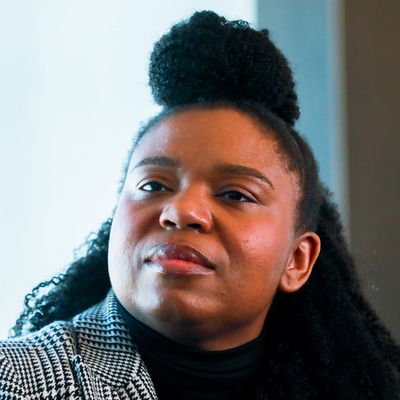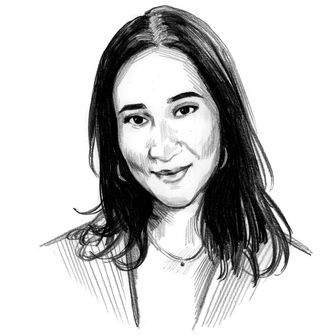
Sex work and exotic dancing in American film and television has been presented, historically, via “sexposition.” Directors like to use naked bodies, mostly women’s, to spice up a dull scene (the Bada Bing ladies of The Sopranos). Sometimes, the sex workers are tragic figures whose main job is to die (nearly every person who sells sex in Game of Thrones) or whose lives and backstories are totally misrepresented (Jennifer Anniston in We’re The Millers). In most cases, sex workers are treated less as characters and more as objects or plot devices; their inner lives are rarely ever explored. As sex worker and writer Audrey Moore put it in a Refinery29 op-ed: “When we’re not being used as disposable symbols of violence, we’re normally presented as the butt of a joke.” Recently, that’s started to change: Lorene Scafaria’s Hustlers set the stage for this in 2019 by delving into the lives of dancers and highlighting the athleticism, and not just the sexuality, of their work. And now P-Valley, a new drama that premiered on Starz this week, expands this universe with even more curiosity.
Created by Memphis-native and playwright Katori Hall (adapted from her 2015 play, Pussy Valley), the show takes us to the Pynk, a strip club in the Mississippi Delta, and into the lives of the mostly Black women who work there. The pilot begins with the retirement of the club’s star dancer, Mercedes (Brandee Evans), and becomes complicated by the arrival of Autumn (Elarica Johnson), a new dancer with a dark past.
Hall, the inimitable talent behind the Olivier Award–winning play The Mountaintop, a fictionalization of the last night of Martin Luther King’s life, spent over a decade researching and writing to make P-Valley what it is today. With an all-female creative team, including directors (Karena Evans, Kimberly Peirce, Tamra Davis, and more) and real dancers, the Starz show does away with the lingering male gaze that inflicts most of the genre, and as Hall explains, puts the audience “in the [dancer’s] high heels.” The result is a sprawling, provocative drama that argues for the humanity and grit of the people who live, thrive, and survive in society’s margins. The Cut spoke with Hall about the show’s conception, adaptation, and what she hopes people will take away from it.
I read that it took you around six years to even do the research for this story. How and where did first get the idea for it?
Growing up, I went to the strip club. With friends, with cousins, it was just a weekend thing to do. For women in the South, it’s part of your coming of age experience, part of what you do. And the strip-club culture down South is the center of a lot of social activity.
I remember going into those places and being so enthralled by what I saw on stage. I think most people, when they think of a strip club, they think it’s just women taking their clothes off. And that’s true. But in addition to that, these women are putting on a show, at a Cirque du Soleil kind of level. They’re flying around, they’re holding themselves upside down, they’re lifting other women up while clasping the pole with their thighs. It’s an amazing, captivating experience and most people aren’t privy to that. I grew up knowing that culture existed. Fast forward a decade and now pole dancing has become a little mainstream. There were all these pole fitness classes popping up in gyms and all that.
I remember going to my first pole dancing class and, oh my God, I almost vomited. It was so hard. I could not imagine being able to do that night after night after night for eight hours at a time. That physical exploration was an entry point for me.
How did you go about researching from there?
I started to visit clubs. I talked to over 40 women. The first part of researching was getting people to trust you. I was worried about taking up their moneymaking time by asking them questions. And something interesting happened: I wasn’t there to objectify them, so they were very open to talking about themselves — why they chose their profession, how the profession chose them. I cultivated relationships with many of them; I ended up celebrating my 30th birthday in the women’s locker room at a strip club because they had become my friends.
I was able to learn about who they were as individuals, and every one of them got into dancing for completely different reasons. Sometimes it was, “Girl, I needed to pay my dental bill.” Other times it was, “I was in a relationship and I needed to get out.” It completely ran the gamut. I met their families: husbands, daughters, sisters. Because I have been a witness to so many women’s lives who just happened to dance, I wanted to give that gift to an audience.
You used something called the “Delta Noir” aesthetic, a subversion of the traditional noir aesthetic. Can you tell me more about that and why you chose it?
Delta noir takes traditional noir, which is a genre that is known for its mystery, its sharp aesthetic, its juxtapositions, and gives it a little twist. We use shadow, a lot of saturated color — there’s a grit to it, but the Delta aspect refers to how in the South, everything has a sense of humor about itself, so there’s a lot of lightness and levity that we infuse into it. Traditionally in noir, you don’t see a lot of women of color, or a Black person that’s not a stereotype.
So our show places people who have been marginalized in the center: You have Uncle Clifford, who is our detective, you have Autumn Night, who is a subversion of the femme fatale that exists in traditional noir. It’s this amazing gumbo and revision of a traditional genre of film.
How did you use the aesthetic to subvert the male gaze that makes most of this genre, and how do use it to oppose the way Black women have, traditionally, been hypersexualized on-screen?
There are a ton of images out in the world that have Black women as hypersexualized, and a lot of Black women have inherited all of that baggage. So we had filming conversations about how we were going to frame it, in terms of camera placement and camera movement, so that it always felt like we were behind the eyes of the women who were experiencing this world, and centering their perspective and their desires.
For example, there’s a moment in episode two where you have a woman doing a lap dance, and the men think of her as a sexual object, but we wanted the audience to experience her feeling like a sexual object. So instead focusing completely on her body, we pushed in on her face. We were putting the audience in her high heels so they could understand how it feels to be looked down upon, to be subjugated, to have your ass grabbed by a stranger.
We play with the male gaze, but we subvert it. There’s a history of images where men are front and center at the strip club, and the women are in the backdrop, they’re objects. In P-Valley, you may think that these women are objects, but they are listening, they’re eavesdropping on your business deals, gaining information about you so that they can be empowered.
What do you hope people will take away from this show?
I want people to see themselves in these women who have been marginalized. I want people to see that they have hopes and dreams, they have a past that they’re working through, and that the work that they do is work — and it’s worthy of exploration.
I want people to understand how complicated this world is. It’s a space that we need to learn about if we want to figure out how to dismantle patriarchy, and who better to learn from the women are so often subjugated by it? These women have a lot to say, especially when it comes to talking about issues of race, class, and gender.
Do you think that portrayals of sex work — on shows like P-Valley or in films like Hustlers — might change the way the industry is viewed in the real world?
It all depends on the person who’s creating the story and what perspective they’re coming from. Quite frankly, I’m not interested in seeing a show about a strip club that’s not centered from the female gaze. I do think men who come into that space have interesting stories to tell, I just feel that’s a perspective we’ve already had. Will it lead more creative exploration in this world? It might, but I think what P-Valley does is raise the bar. We are striving for humanity, we are striving to reflect a deeper truth beyond simply looking at women’s bodies. It celebrates women’s bodies, but it shows stripping and pole dancing for the athletic pursuit that it is.





